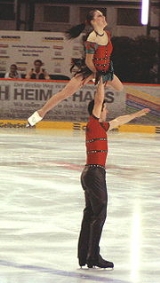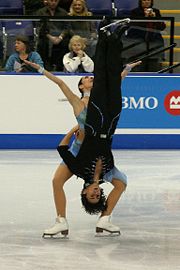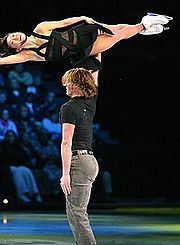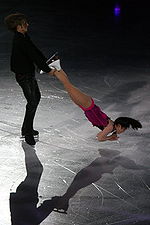
Figure skating lifts
Encyclopedia
Figure skating lifts are a required element in pair skating
and ice dancing
. Pairs lifts differ from dance lifts most notably in that dancers are not allowed to lift their partners above their shoulders. Lifts are also executed by synchronized skating
teams in the free program in competition, as part of a movements in isolation requirement.
 Dance lifts are differentiated by the skating involved. There are seven kinds of lifts approved for ISU
Dance lifts are differentiated by the skating involved. There are seven kinds of lifts approved for ISU
competitions.
Only two of the above spread eagle positions may be used in a single program.
& Gwendal Peizerat
, Federica Faiella
& Massimo Scali
and Sinead Kerr
& John Kerr
.
sets down length requirements for lifts in programs and skaters are penalized if a lift goes on for too long.
For the 2006-2007 season, at the senior level, the original dance
required two lifts not to be longer than six seconds each. For the free dance
, four lifts were required and they were separated into short and long.
 Unlike dance lifts, pair lifts are typically over the man's head. Most pair lifts are rotational, with the man turning on the ice before setting the lady down; a carry lift, by contrast, is a lift without rotation. A lift's score may be affected by
Unlike dance lifts, pair lifts are typically over the man's head. Most pair lifts are rotational, with the man turning on the ice before setting the lady down; a carry lift, by contrast, is a lift without rotation. A lift's score may be affected by
Lifts are grouped by the holds involved. The ISU defines five different groups of pair lifts, with an ascending difficulty level, although levels 3 and 4 are the same level of difficulty. In ISU senior level competition, the man must rotate more than one times, but fewer than three a half. Lifts that go on longer may receive deductions. The group is determined by the hold held at the moment the woman passes the man's shoulder in the lift.
Lifts are named by either their takeoff and landing edges (in which case, they are named after the jump with the same sort of takeoff), the air position, or the method in which the lady is raised into the air.
In hand to hand lasso lifts, the lady's position changes in the air. The lift begins with the skaters skating facing each other, but at the top of the lift, they are facing the same direction. The term lasso comes from the way the woman's body swings around as she changes position. The woman takes off from a forward outside edge behind the man, and the take-off looks like an axel jump
.
Lasso lifts are either forward or reverse. In reverse, the woman begins the lift skating backward. In forward, she is skating forward.
A notable lasso variation is the helicopter. In this variation, the skaters perform a forward lasso lift, but the woman changes position at the top of the lift, parallel to the ice, with her back arched and her legs spread in a V position, so that as the man turns, her legs look like the blades on a helicopter.

 Any hold not listed above is not legal in ISU competition. However, there are many lifts which are common in show skating.
Any hold not listed above is not legal in ISU competition. However, there are many lifts which are common in show skating.
Lifts without rotations are called carry lifts and are allowed once in the long program.
For the 2006-2007 season, senior level competition required a maximum of three lifts, with one from group 3 or 4, and one twist lift in the long program. The short program required a hand-to-hand lift take-off from group 4, and a twist lift.
2007-2008 competition at the senior level will require a lasso-lift take-off (Group five).
Pair skating
Pair skating is a figure skating discipline. International Skating Union regulations describe pair teams as consisting of "one lady and one man." The sport is distinguished from ice dancing and single skating by elements unique to pair skating, including overhead lifts, twist lifts, death spirals,...
and ice dancing
Ice dancing
Ice dancing is a form of figure skating which draws from the world of ballroom dancing. It was first competed at the World Figure Skating Championships in 1952, but did not become a Winter Olympic Games medal sport until 1976....
. Pairs lifts differ from dance lifts most notably in that dancers are not allowed to lift their partners above their shoulders. Lifts are also executed by synchronized skating
Synchronized skating
Synchronized skating or synchronised skating, a large and fast-growing discipline, consists of 8—20 athletes skating on ice at one time moving as one flowing unit at high speeds...
teams in the free program in competition, as part of a movements in isolation requirement.
Dance lifts

International Skating Union
The International Skating Union is the international governing body for competitive ice skating disciplines, including figure skating, synchronized skating, speed skating, and short track speed skating. It was founded in Scheveningen, Netherlands in 1892, making it one of the oldest international...
competitions.
Short lifts
These lifts may last up to six seconds in competition on the senior level.- Stationary Lift - A lift performed "on the spot". The lifting partner does not move across the ice, but is allowed to rotate.
- Straight Line Lift - The lifting partner moves in a straight line across the ice. This lift may be performed on one foot or two.
- Curve Lift - The lifting partner moves along a curve across the ice. This lift may be performed on one foot or two.
- Rotational Lift - The lifting partner rotates in one direction while traveling across the ice.
Long lifts
These lifts may last up to ten seconds in competition on the senior level.- Reverse Rotational Lift - The lifting partner rotates in one direction, then switches and rotates in the other direction, while traveling across the ice.
- Serpentine Lift - The lifting partner moves in a serpentine pattern across the ice.
- Combination Lift - A lift combining two of the four short lifts. Each part of the lift must be fully established.
Positions
Each position must be held for at least three seconds to count for levels. Each position is permitted only once a program.For the lifting partner
- One foot
- Shoot the duck
- Spread eagleSpread eagle (figure skating)The spread eagle is one of the moves in the field in the sport of figure skating, in which a skater glides on both feet, the toes turned out to the sides, heels facing each other. It can be performed on either the inside or outside edges. It is commonly used as an entrance to jumps, adding to the...
- inside edge - Spread eagleSpread eagle (figure skating)The spread eagle is one of the moves in the field in the sport of figure skating, in which a skater glides on both feet, the toes turned out to the sides, heels facing each other. It can be performed on either the inside or outside edges. It is commonly used as an entrance to jumps, adding to the...
- outside edge - Spread eagleSpread eagle (figure skating)The spread eagle is one of the moves in the field in the sport of figure skating, in which a skater glides on both feet, the toes turned out to the sides, heels facing each other. It can be performed on either the inside or outside edges. It is commonly used as an entrance to jumps, adding to the...
- straight line, for the Straight Line lift only - Ina Bauer
- Crouching, with both knees bent, on both feet
- Crouching, with one knee bent and the other leg extended to the side
- Lunge, with the free leg in any position
- One hand lift.
- Rounding above the Shoulder
Only two of the above spread eagle positions may be used in a single program.
For the lifted partner
- Full split (180 degrees)
- Full Biellmann position with the leg held above the head.
- Full doughnut/ring with one or both legs held close to the head
- Upside down combined with difficult hold
- Vertical position with a cantileverCantilever (figure skating)The cantilever is a figure skating element. Similar to the spread eagle, the skater travels along a deep edge. With knees bent, the skater bends his or her back backwards, parallel to the ice....
- A horizontal position with only one point of support
- Leaning forwards or backwards with the legs as the only points of support
- Full layback positionLayback spinA layback spin is an upright figure skating spin in which the head and shoulders are dropped backwards and the back arched downwards toward the ice. A common variation has the free leg lifted toward the back, typically in an attitude position, with the arms held above the body...
with no support from the other partner above the thigh. - Leaning out with the body and legs in a horizontal line with the shoulders and/or upper back as the points of support.
"Reverse" lifts
In ice dancing, the lifting partner is usually the man and the lifted partner is usually the woman. However, the rules allow for the woman to lift the man in competition. Notable couples who have performed "reverse" or "genderbending" lifts are Marina AnissinaMarina Anissina
Marina Vyacheslavovna Anissina is a French-Russian ice dancer. With partner Gwendal Peizerat, she is the 2002 Olympic champion.- Career :...
& Gwendal Peizerat
Gwendal Peizerat
Gwendal Peizerat is a French ice dancer. With Marina Anissina, he is the 2002 Olympic champion, the 1998 Olympic bronze medalist, the 2000 World Champion, and a six-time French National Champion.-Biography:...
, Federica Faiella
Federica Faiella
Federica Faiella is an Italian ice dancer. She competes with Massimo Scali. They are the 2010 World bronze medalists, 2009 & 2010 European silver medalists and six-time Italian national champions. They have won eleven Grand Prix medals.-Early career:Faiella began skating at the age of ten...
& Massimo Scali
Massimo Scali
Massimo Scali is an Italian ice dancer. With partner Federica Faiella, he is the 2010 World bronze medalist, the 2009 & 2010 European silver medalist and a six-time Italian national champion. They have won eleven Grand Prix medals.-Career:- Early years :Massimo Scali began skating at the age of ten...
and Sinead Kerr
Sinead Kerr
Sinead Houston Kerr is a Scottish ice dancer who represents Great Britain. She teamed up with her brother John Kerr in 2000. They are two-time European bronze medalists and the 2004–2010 British national champions...
& John Kerr
John Kerr (figure skater)
John Alastair Kerr is a Scottish ice dancer who represents Great Britain. He competes with his sister Sinead Kerr...
.
Extended lifts & program requirements
The International Skating UnionInternational Skating Union
The International Skating Union is the international governing body for competitive ice skating disciplines, including figure skating, synchronized skating, speed skating, and short track speed skating. It was founded in Scheveningen, Netherlands in 1892, making it one of the oldest international...
sets down length requirements for lifts in programs and skaters are penalized if a lift goes on for too long.
For the 2006-2007 season, at the senior level, the original dance
Original dance
The original dance was a segment of an ice dancing competition. It was usually the second of three programs, sandwiched between the compulsory dances and the free dance. Until 1994, it was known as the original set pattern dance...
required two lifts not to be longer than six seconds each. For the free dance
Free dance (figure skating)
The free dance is a part of an ice dancing competition. It is the second part of the competition to be contested, after the short dance.-Structure and content:...
, four lifts were required and they were separated into short and long.
Pair lifts

- Type of entry – May raise difficulty by entry in spread eagle, arabesque or other position.
- Type of lift – See below.
- Ice coverage – The distance across the ice traveled by the man as he carries his partner.
- Speed – Speed across the ice. Marks may be lower if man slows down significantly over the course of the lift.
- Quality of the lady's position – Posture, stretch, extension.
- Changes of position – May raise difficulty by changes of position during the lift or switching to one-hand hold
- Man's footwork – Clean turns and stability throughout the lift
- Dismount – Both partners on one foot as they exit the lift. May raise difficulty by one-hand dismount, a flip out, or other.
- Other features – e.g. rotating in one direction, stopping and reversing the rotation
Lifts are grouped by the holds involved. The ISU defines five different groups of pair lifts, with an ascending difficulty level, although levels 3 and 4 are the same level of difficulty. In ISU senior level competition, the man must rotate more than one times, but fewer than three a half. Lifts that go on longer may receive deductions. The group is determined by the hold held at the moment the woman passes the man's shoulder in the lift.
Lifts are named by either their takeoff and landing edges (in which case, they are named after the jump with the same sort of takeoff), the air position, or the method in which the lady is raised into the air.
Group 1: Armpit hold lifts
- Lutz lift
- Flip lift
- Axel liftAxel liftAn axel lift, in pairs figure skating is a movement in which the woman is turned over her partner's head one and a half times.From a position of holding hands on one side, her partner lifts her with his hand under her armpit and the lift begins from the woman's outside forward edge and ends on the...
: The man and woman skate face to face, with the man going backwards. The lady lifts up from a forward outside edge (hence the axel name), and is set down again on the back outside edge.
Group 2: Waist hold lifts
- Waist loop lift
- Platter lift: The woman's position in the air is parallel to the ice so that she resembles a platter being held up. It is also sometimes known as a tabletop lift. Platter lifts are either forward or reverse. In reverse platter lifts, the woman is skating backwards. In forward, she is skating forwards.
Group 3: Hand to hip lifts
- Cartwheel lift
- Star lift: The skaters skate face to face. The man has one hand on his partner's hip and the other clasping her hand. He raises her until she is horizontal with her free hand on his shoulder. The air position for this lift is a leg variation with her legs spread in a scissor position as if they were the points on a star, where is where the lift gets its name. The lift can be made more difficult if she lets go of his shoulder, or if he lets go of her hand and she is supported only by her hip.
- Toe loop hip lift: The skaters skate backwards with him holding her by the hip. The woman picks her toe-pick as if doing a toe loop jumpToe loop jumpThe toe loop is one of the simplest jumps in figure skating. It is usually the second jump learned after the salchow. It is a toe pick-assisted jump that takes off and lands on the same backward outside edge. - Toe loop technique :...
, hence the name. The skaters turn together in the air. - Platter/swan/table top lift
Group 4: Hand to hand (press lift types)
- Press lift: The skaters skate facing each other, with the man skating backwards. They clasp hands and the man pushes forward and up, "pressing" her into the lift. The man and the woman face different directions in the air.
- Hand to hand loop lift: The skaters are facing in the same direction. The man raises the woman above his head and she remains facing the same direction in the air while in a sitting position with her hands behind her. The take off for this is the back outside edge, like the loop jumpLoop jumpThe Loop jump is a figure skating jump that takes off from a back outside edge and lands on the same backwards outside edge. For a jump with counterclockwise rotation, this is the right back outside edge. It is named from its similarity to the loop compulsory figure. The invention is widely...
. - Loop press/back press lift
Group 5: Hand to hand (lasso lift types)
- Step up lasso
- Toe lasso: The woman skates forward and the man skates backward. She is lifted into the air from a backward toe takeoff, like a toe loop jumpToe loop jumpThe toe loop is one of the simplest jumps in figure skating. It is usually the second jump learned after the salchow. It is a toe pick-assisted jump that takes off and lands on the same backward outside edge. - Toe loop technique :...
. - Toe overhead lift: The woman is swung behind the man's head from one side of his body to the other, into a raised position. She is in a split position and they are facing the same direction. The toe-pick is used in her take off, hence the name.
- Step overhead lift: The same as the toe overhead lift, but the woman does not use a toe-assist in the take off.
In hand to hand lasso lifts, the lady's position changes in the air. The lift begins with the skaters skating facing each other, but at the top of the lift, they are facing the same direction. The term lasso comes from the way the woman's body swings around as she changes position. The woman takes off from a forward outside edge behind the man, and the take-off looks like an axel jump
Axel jump
The Axel is a figure skating jump with a forward take-off. It is named after the Norwegian skater Axel Paulsen, who first performed the jump in 1882. An Axel jump has an extra ½ rotation in the air due to its forward take-off...
.
Lasso lifts are either forward or reverse. In reverse, the woman begins the lift skating backward. In forward, she is skating forward.
A notable lasso variation is the helicopter. In this variation, the skaters perform a forward lasso lift, but the woman changes position at the top of the lift, parallel to the ice, with her back arched and her legs spread in a V position, so that as the man turns, her legs look like the blades on a helicopter.
For the lifting partner
Unlike ice dancing, the lifting partner has only two possible positions.- Rotating: Most lifts are performed with the man rotating across the ice.
- Carry: A carry lift is a lift in which the man does not rotate. He may skate on one foot, or perform crossovers or a spread eagleSpread eagle (figure skating)The spread eagle is one of the moves in the field in the sport of figure skating, in which a skater glides on both feet, the toes turned out to the sides, heels facing each other. It can be performed on either the inside or outside edges. It is commonly used as an entrance to jumps, adding to the...
to earn a higher level of difficulty.
For the lifted partner
There are three basic air positions for the lifted partner.- Upright: the lady's upper body vertical
- Star: the lady's position sideways with the upper body parallel to the ice.
- Platter: the lady's position flat, parallel to the ice, facing either up or down.
Illegal positions


- The Detroiter is performed by the man lifting the lady over his head, holding her parallel to the ice while he is in a two-foot spin. The hold is the most dangerous part of the spin because the man is supporting the lady only by her legs. This move is also performed in more dramatic and dangerous fashion with a one-handed hold.
- A headbanger or bounce spin is performed by the man swinging the lady around with both of her feet off the ice, supported only by the man's grip on her ankle. The lady is elevated and lowered during the spin in a periodic fashion, sometimes with her head coming dangerously close to skimming the ice.
Extended lifts & program requirements
Lifts may not last longer than three and a half rotations by the lifting partner in ISU senior level competition. Lifts that last longer will be penalized.Lifts without rotations are called carry lifts and are allowed once in the long program.
For the 2006-2007 season, senior level competition required a maximum of three lifts, with one from group 3 or 4, and one twist lift in the long program. The short program required a hand-to-hand lift take-off from group 4, and a twist lift.
2007-2008 competition at the senior level will require a lasso-lift take-off (Group five).

